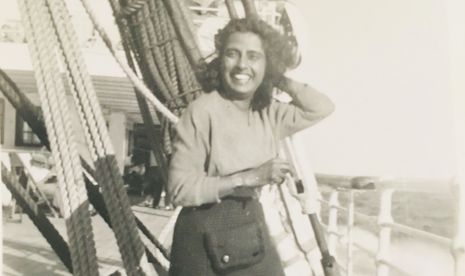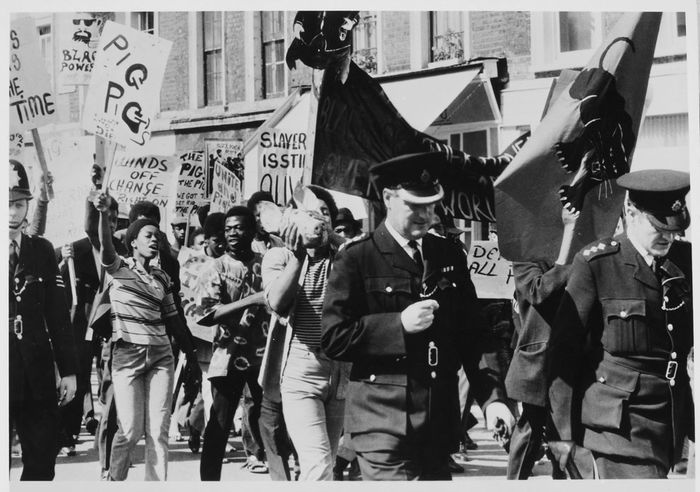British Asians Must Rediscover Our Radical Past
Arran Parry-Davies explores the history of anti-racism and working-class solidarity in the British Asian community, arguing that this has a contemporary relevance and necessity.

British Asians have become the face of the modern Conservative Party. Four South Asian politicians, including the Chancellor Rishi Sunak and the Home Secretary Priti Patel, now occupy two of the most senior offices in the country. This would seem an obvious win for anti-racists - more brown faces in high places will change things for the better. However, from the Home Secretary's punitive Immigration Bill to the lacklustre response to the Black Lives Matter protests, we’ve seen how this logic has been naive at best, insidious at worst.
South Asian Conservative politicians are being used to further an agenda that harms Britain's Black communities and to silence criticism of the Government’s actions on racial inequality. Just last week, Home Secretary Priti Patel used her past experiences of racial discrimination to evade and gaslight Black Labour MP Florence Eshalomi, who criticised the government’s failure to truly acknowledge the anger over racial injustice that recent BLM protests have demonstrated. This is a betrayal of a long history of anti-racist and socialist activism in the Asian community and perpetuates a false narrative of a homogenous Asian community free from issues of discrimination and economic precarity.
"For my mum’s generation in the 1970s, their childhood was lived in the shadow of the far right National Front...."
While it serves their personal and Party interests to portray British Indians as a ‘model minority,' it is deeply damaging to Asian communities at large. The Home Secretary recently remarked: “My father always told me: 'Hold your head up high and go forwards. We live in a great country where we have the freedom to succeed.’” This sort of rhetoric seems more designed to appease the Conservative base than to reflect the lived experiences of British Asian and Black communities that have always been at the sharp end of racism. For my grandparents, racism was a fact of everyday life in 1950s Britain - contained within the housing they could live in to the jobs they had access to. For my mum’s generation in the 1970s, their childhood was lived in the shadow of the far right National Front marching through Britain's towns and cities. Overt discrimination may now appear rarer but institutional racism remains intact. Over half of British Bangladeshi and Pakistani households as well as 1 in 4 British Indian households remain in poverty.
To understand this present proliferation of Asian Conservatives, we have to look back at the history of British migration. South Asian migration occurred primarily in two waves, with the second wave known as the ‘double migrants’ occurring in the 1960s and 1970s. These were Indian migrants that had settled in British territories in Africa - primarily Uganda and Kenya - at the turn of the 20th century. The British saw them as ‘civilisers’ that would act on behalf of the Empire and work in colonial bureaucracies overseeing the construction of the Kenya-Uganda railway. These Asian communities enjoyed relative prosperity: in Uganda, Asians were 1% of the population but controlled a fifth of the wealth and enjoyed a racial hierarchy placing them above the native African populations. Therefore, when these communities arrived in Britain, they largely imported with them significant economic wealth, assisting their financial success, but also an anti-blackness shaped by the colonial rule in which they had lived. It is from this group, notably, that all the present Conservative cabinet are drawn from.
"... working class Asian women led one of the largest trade union strikes in British history..."
At the same time in 1980s Britain, Thatcher’s free market explosion was in full force. This wave of East-African Asians provided the perfect symbol for her ideology: prizing hard work, self-reliance and entrepreneurialism. As the Business Secretary Alok Sharma described of Thatcher: “she might not look like us but she absolutely thought like us”. The Conservative Party saw an opportunity to expand its voter base to this group and exploit ‘divide and rule’ politics among Britain's minorities. In recent years, this has often been accompanied with distinctly Isamophobic dogwhitsles, seeking to capitalise on post-partition religious tension, re-ignited with the election of Hindu nationalist Indian Prime Minister Narendra Modi in 2014. Zac Goldmith’s campaign for the London mayoralty in 2016, for example, played heavily on his opponent, Sadiq Khan’s Muslim heritage through accusations that he was giving 'oxygen' to extremist groups.
This second wave of migration, though smaller than the first, has begun to distort the history of British Asian communities. The majority of the first wave emigrated in the late 1940s and 1950s to fill gaps in the post-war labour market, principally the textiles industries. They settled primarily in the North-West, Midlands and inner-London and have a long history of involvement in the labour and anti-racist movements along with a history of committed support to the Labour Party. My grandfather belonged to this generation - a proud trade union member with bookshelves of Black radicals like Malcom X.
There was a strong sense of political ‘blackness’ - the idea that South Asian and African Caribbean communities should unite behind shared struggles of racist policing, economic precarity and racialised housing discrimination. As the author Ambalavaner Sivananda describes: “In the workplace and the community, Afro-Caribbean and Asian, we were a community and a class, we closed ranks and took up each other’s struggles”. This led to the formation of politically ‘black’ self-help organisations such as the United Coloured People’s Alliance, and the Black Liberation Front that organised against police brutality and increasingly draconian immigration law in the 1970s. Asian women, through groups like the Southall Black Sisters, were also active in the women’s movement of the 1980s, challenging its white, middle-class gaze that too often overlooked communal issues like ‘honour’ killings and forced marriage. Whilst in the labour movement, working class Asian women led one of the largest trade union strikes in British history when in 1976 they walked out of Grunwick Film Processing Laboratories in London, demanding trade union recognition, higher wages and an end to the exploitation of migrant workers.
The Black Lives Matter Movement has shown, at this time more than ever, that solidarity among Britain's minority communities is needed. The Asian community has a proud legacy of fighting against racism, rejecting anti-blackness and standing on picket lines. Let’s not let the Tories define our history.
 News / Fitz students face ‘massive invasion of privacy’ over messy rooms23 April 2024
News / Fitz students face ‘massive invasion of privacy’ over messy rooms23 April 2024 News / Climate activists smash windows of Cambridge Energy Institute22 April 2024
News / Climate activists smash windows of Cambridge Energy Institute22 April 2024 News / Copycat don caught again19 April 2024
News / Copycat don caught again19 April 2024 Comment / Gown vs town? Local investment plans must remember Cambridge is not just a university24 April 2024
Comment / Gown vs town? Local investment plans must remember Cambridge is not just a university24 April 2024 News / Cambridge University disables comments following Passover post backlash 24 April 2024
News / Cambridge University disables comments following Passover post backlash 24 April 2024





